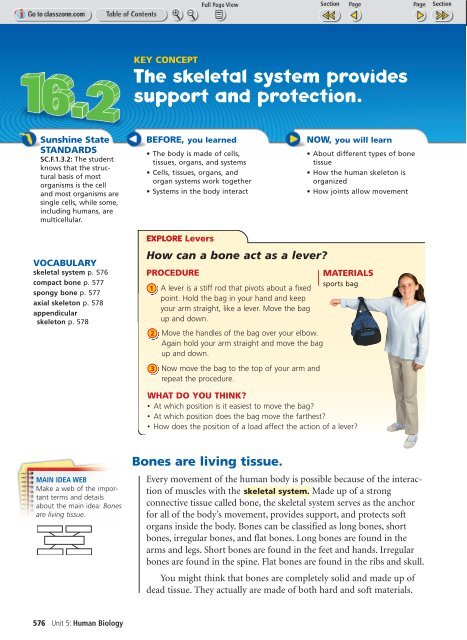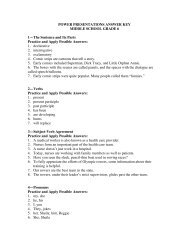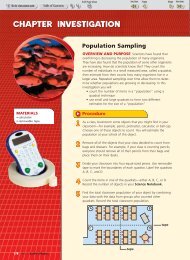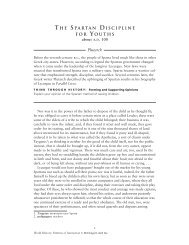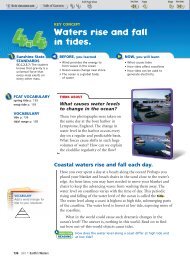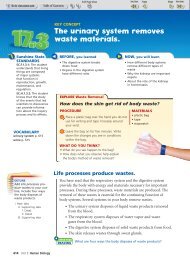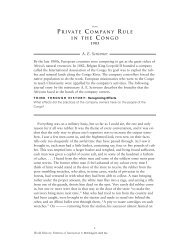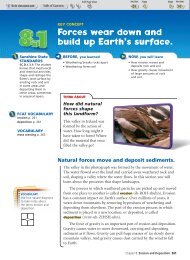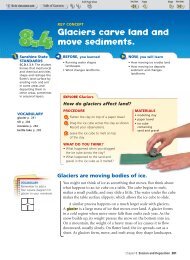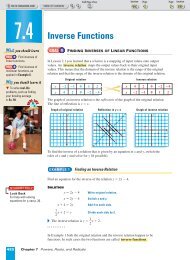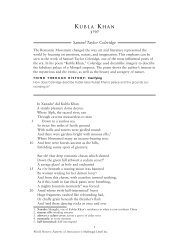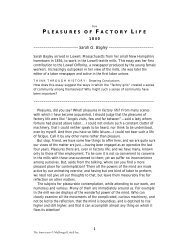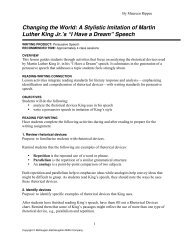The skeletal system provides support and protection. - ClassZone
The skeletal system provides support and protection. - ClassZone
The skeletal system provides support and protection. - ClassZone
You also want an ePaper? Increase the reach of your titles
YUMPU automatically turns print PDFs into web optimized ePapers that Google loves.
Sunshine State<br />
STANDARDS<br />
SC.F.1.3.2: <strong>The</strong> student<br />
knows that the structural<br />
basis of most<br />
organisms is the cell<br />
<strong>and</strong> most organisms are<br />
single cells, while some,<br />
including humans, are<br />
multicellular.<br />
VOCABULARY<br />
<strong>skeletal</strong> <strong>system</strong> p. 576<br />
compact bone p. 577<br />
spongy bone p. 577<br />
axial skeleton p. 578<br />
appendicular<br />
skeleton p. 578<br />
MAIN IDEA WEB<br />
Make a web of the important<br />
terms <strong>and</strong> details<br />
about the main idea: Bones<br />
are living tissue.<br />
576 Unit 5: Human Biology<br />
KEY CONCEPT<br />
<strong>The</strong> <strong>skeletal</strong> <strong>system</strong> <strong>provides</strong><br />
<strong>support</strong> <strong>and</strong> <strong>protection</strong>.<br />
BEFORE, you learned<br />
• <strong>The</strong> body is made of cells,<br />
tissues, organs, <strong>and</strong> <strong>system</strong>s<br />
• Cells, tissues, organs, <strong>and</strong><br />
organ <strong>system</strong>s work together<br />
• Systems in the body interact<br />
EXPLORE Levers<br />
How can a bone act as a lever?<br />
PROCEDURE<br />
1<br />
2<br />
3<br />
A lever is a stiff rod that pivots about a fixed<br />
point. Hold the bag in your h<strong>and</strong> <strong>and</strong> keep<br />
your arm straight, like a lever. Move the bag<br />
up <strong>and</strong> down.<br />
Move the h<strong>and</strong>les of the bag over your elbow.<br />
Again hold your arm straight <strong>and</strong> move the bag<br />
up <strong>and</strong> down.<br />
Now move the bag to the top of your arm <strong>and</strong><br />
repeat the procedure.<br />
Bones are living tissue.<br />
NOW, you will learn<br />
•About different types of bone<br />
tissue<br />
• How the human skeleton is<br />
organized<br />
• How joints allow movement<br />
MATERIALS<br />
sports bag<br />
WHAT DO YOU THINK?<br />
• At which position is it easiest to move the bag?<br />
• At which position does the bag move the farthest?<br />
• How does the position of a load affect the action of a lever?<br />
Every movement of the human body is possible because of the interaction<br />
of muscles with the <strong>skeletal</strong> <strong>system</strong>. Made up of a strong<br />
connective tissue called bone, the <strong>skeletal</strong> <strong>system</strong> serves as the anchor<br />
for all of the body’s movement, <strong>provides</strong> <strong>support</strong>, <strong>and</strong> protects soft<br />
organs inside the body. Bones can be classified as long bones, short<br />
bones, irregular bones, <strong>and</strong> flat bones. Long bones are found in the<br />
arms <strong>and</strong> legs. Short bones are found in the feet <strong>and</strong> h<strong>and</strong>s. Irregular<br />
bones are found in the spine. Flat bones are found in the ribs <strong>and</strong> skull.<br />
You might think that bones are completely solid <strong>and</strong> made up of<br />
dead tissue. <strong>The</strong>y actually are made of both hard <strong>and</strong> soft materials.
Like your heart or skin, bones are living tissue. Bones are not completely<br />
solid, either; they have spaces inside. <strong>The</strong> spaces allow blood<br />
carrying nutrients to travel throughout the bones. Because bones have<br />
spaces, they weigh much less than they would if they were solid.<br />
Two Types of Bone Tissue<br />
Every bone is made of two types of bone tissue: compact bone <strong>and</strong><br />
spongy bone. <strong>The</strong> hard compact bone surrounds the soft spongy<br />
bone. Each individual bone cell lies within a bony web. This web is<br />
made up mostly of minerals containing calcium.<br />
Compact Bone Surrounding the spongy, inner layer of the bone is a<br />
hard layer called compact bone. Compact bone functions as the basic<br />
<strong>support</strong>ive tissue of the body, the part of the body you call the skeleton.<br />
<strong>The</strong> outer layer of compact bone is very hard <strong>and</strong> tough. It covers<br />
the outside of most bones.<br />
Spongy Bone Inside the bone, the calcium network is less dense. This<br />
tissue is called spongy bone. Spongy bone is strong but lightweight. It<br />
makes up most of the short, flat, <strong>and</strong> irregular bones found in your<br />
body. It also makes up the ends of long bones.<br />
Marrow <strong>and</strong> Blood Cells<br />
Within the spongy bone tissue is marrow, the part of the bone that<br />
produces blood cells. <strong>The</strong> new blood cells travel from the marrow into<br />
the blood vessels that run throughout the bone. <strong>The</strong> blood brings<br />
nutrients to the bone cells <strong>and</strong> carries waste materials away.<br />
A Close Look at Bone<br />
All bone, like the long bone shown here, is made up<br />
of compact bone tissue <strong>and</strong> spongy bone tissue.<br />
Compact bone is dense<br />
tissue that gives the bone<br />
much of its strength.<br />
Blood vessels transport<br />
new red blood cells from the<br />
marrow <strong>and</strong> carry materials<br />
to <strong>and</strong> from the bone.<br />
Spongy bone is<br />
strong <strong>and</strong> lightweight.<br />
Marrow, which produces<br />
blood cells, fills the spaces<br />
in spongy bone.<br />
RESOURCE CENTER<br />
CLASSZONE.COM<br />
Explore the <strong>skeletal</strong><br />
<strong>system</strong>.<br />
Calcium network<br />
Chapter 16: Systems, Support, <strong>and</strong> Movement 577
VOCABULARY<br />
Remember to add four<br />
squares for axial skeleton<br />
<strong>and</strong> appendicular skeleton<br />
to your notebook.<br />
SIMULATION<br />
CLASSZONE.COM<br />
Assemble a skeleton.<br />
578 Unit 5: Human Biology<br />
<strong>The</strong> skeleton is the body’s framework.<br />
Like the frame of a building, the skeleton <strong>provides</strong> the body’s shape.<br />
<strong>The</strong> skeleton also works with other <strong>system</strong>s to allow movement.<br />
Scientists have identified two main divisions in the skeleton. <strong>The</strong>se are<br />
the axial (AK-see-uhl) skeleton, which is the central part of the skeleton,<br />
<strong>and</strong> the appendicular (AP-uhn-DIHK-yuh-luhr) skeleton. Bones in<br />
the appendicular skeleton are attached to the axial skeleton. <strong>The</strong> diagram<br />
on page 579 labels some of the important bones in your skeleton.<br />
<strong>The</strong> Axial Skeleton<br />
Imagine a line straight down your back. You can think of that line as<br />
an axis. Sitting, st<strong>and</strong>ing, <strong>and</strong> twisting are some of the motions that<br />
turn around the axis. <strong>The</strong> axial skeleton is the part of the skeleton<br />
that forms the axis. It <strong>provides</strong> <strong>support</strong> <strong>and</strong> <strong>protection</strong>. In the diagram,<br />
parts of the axial skeleton are colored in red.<br />
<strong>The</strong> axial skeleton includes the skull, or the cranium (KRAY-neeuhm).<br />
<strong>The</strong> major function of the cranium is <strong>protection</strong> of the brain.<br />
Most of the bones in the cranium do not move. <strong>The</strong> skull connects to<br />
the spinal column in a way that allows the head to move up <strong>and</strong> down<br />
as well as right <strong>and</strong> left.<br />
Your spinal column makes up the main portion of the axial skeleton.<br />
<strong>The</strong> spinal column is made up of many bones called vertebrae.<br />
<strong>The</strong> many bones allow flexibility. If you run your finger along your<br />
back you will feel the vertebrae. Another set of bones belonging to the<br />
axial skeleton are the rib bones. <strong>The</strong> ribs function to protect the soft<br />
internal organs, such as the heart <strong>and</strong> lungs.<br />
<strong>The</strong> Appendicular Skeleton<br />
<strong>The</strong> diagram shows the bones in the appendicular skeleton in yellow.<br />
Bones in the appendicular skeleton function mainly to allow movement.<br />
<strong>The</strong> shoulder belongs to the upper part of the appendicular<br />
skeleton. <strong>The</strong> upper arm bone that connects to the shoulder is the<br />
longest bone in the upper body. It connects with the two bones of the<br />
lower arm. <strong>The</strong> wristbone is the end of one of these bones in the<br />
lower arm.<br />
<strong>The</strong> lower part of the body includes the legs <strong>and</strong> the hip bones. This<br />
part of the body bears all of the body’s weight when you are st<strong>and</strong>ing.<br />
<strong>The</strong> leg bones are the strongest of all the bones in the skeleton. Just as<br />
the lower arm includes two bones, the lower leg has two bones. <strong>The</strong><br />
larger of these two bones carries most of the weight of the body.<br />
Check Your Reading How are the axial <strong>and</strong> appendicular skeletons alike?<br />
How are they different?
<strong>The</strong> Skeletal System<br />
<strong>The</strong> <strong>skeletal</strong> <strong>system</strong> interacts with other body <strong>system</strong>s to<br />
allow this soccer player to st<strong>and</strong>, run, <strong>and</strong> kick.<br />
axial skeleton<br />
appendicular<br />
skeleton<br />
<strong>The</strong> vertebrae of<br />
the spinal column<br />
protect the spinal<br />
cord <strong>and</strong> <strong>support</strong><br />
the cranium <strong>and</strong><br />
other bones.<br />
<strong>The</strong> skull protects<br />
the brain.<br />
Twelve pairs of<br />
ribs protect the<br />
lungs <strong>and</strong> heart.<br />
<strong>The</strong> kneecap is<br />
called the patella.<br />
<strong>The</strong> lower jaw is the<br />
only bone in the skull<br />
that can move.<br />
<strong>The</strong> shoulder<br />
blade is called<br />
the scapula.<br />
<strong>The</strong> upper arm bone is<br />
called the humerus.<br />
<strong>The</strong> many bones in the<br />
wrist <strong>and</strong> the h<strong>and</strong> allow<br />
the h<strong>and</strong> to perform a<br />
great variety of activities.<br />
<strong>The</strong> upper leg bone, called<br />
the femur, is the longest<br />
bone in the body.<br />
<strong>The</strong> lower leg bones<br />
are called the tibia<br />
<strong>and</strong> the fibula.<br />
<strong>The</strong>re are 26<br />
bones in the ankle<br />
<strong>and</strong> the foot.<br />
<strong>The</strong> word appendicular has the same root as the word append, which means to<br />
attach. How do you think this word applies to the appendicular skeleton?<br />
<strong>The</strong> lower<br />
arm bones<br />
are the ulna<br />
<strong>and</strong> radius.<br />
Chapter 16: Systems, Support, <strong>and</strong> Movement 579
MAIN IDEA WEB Make a<br />
web of the important<br />
terms <strong>and</strong> details about<br />
the main idea: <strong>The</strong> skeleton<br />
changes as the body<br />
develops <strong>and</strong> ages.<br />
reminder<br />
Density is the ratio of mass<br />
over volume. Bone density is<br />
a measure of the mass of a<br />
bone divided by the bone’s<br />
volume.<br />
A bone scan shows bone density<br />
using color.<br />
580 Unit 5: Human Biology<br />
<strong>The</strong> skeleton changes as the body develops<br />
<strong>and</strong> ages.<br />
You will remember that bones are living tissue. During infancy <strong>and</strong><br />
childhood, bones grow as the rest of the body grows. Bones become<br />
harder as they stop growing. In adulthood, bones continue to change.<br />
Infancy <strong>The</strong> skull of a newborn is made up of several bones that have<br />
spaces between them. As the brain grows, the skull also grows. During<br />
the growth of the skull, the spaces between the bones close.<br />
Childhood Bone growth occurs at areas called growth plates. <strong>The</strong>se<br />
growth plates are made of cartilage, a firm, flexible connective tissue.<br />
<strong>The</strong> length <strong>and</strong> shape of bones is determined by growth plates. Long<br />
bones grow at the ends of the bone surrounding growth plates.<br />
Adolescence At the end of adolescence (AD-uhl-EHS-uhns) bones stop<br />
growing. <strong>The</strong> growth plate is the last portion of the bone to become<br />
hard. Once growth plates become hard, arms <strong>and</strong> legs stop growing <strong>and</strong><br />
the skull plates fuse.<br />
Adulthood Even after bones stop growing, they go through cycles in<br />
which old bone is broken down <strong>and</strong> new bone is formed. As people<br />
age, more bone is broken down than is formed. This can lead to a<br />
decrease in bone mass, which causes a decrease in bone density. <strong>The</strong><br />
strength of bones depends upon their density. As people age, their<br />
bone density may decrease. Bones that are less dense may break more<br />
easily. Many doctors recommend that adults over a certain age get<br />
regular bone density tests.<br />
Test of Bone Density<br />
<strong>The</strong> computer is recording<br />
the density of the bones<br />
in the lower spine.
Joints connect parts of the <strong>skeletal</strong> <strong>system</strong>.<br />
A joint is a place at which two parts of the <strong>skeletal</strong> <strong>system</strong> meet. <strong>The</strong>re<br />
are three types of joints: immovable, slightly movable, <strong>and</strong> freely<br />
movable.<br />
Immovable <strong>and</strong> Slightly Movable Joints An immovable joint locks<br />
bones together like puzzle pieces. <strong>The</strong> bones of your skull are<br />
connected by immovable joints. Slightly movable joints are able to flex<br />
slightly. Your ribs are connected to your sternum by slightly movable<br />
joints.<br />
Freely Movable Joints Freely movable joints allow your body to bend<br />
<strong>and</strong> to move. Tissues called ligaments hold the bones together at<br />
movable joints. Other structures inside the joint cushion the bones<br />
<strong>and</strong> keep them from rubbing together. <strong>The</strong> entire joint also is surrounded<br />
by connective tissue.<br />
Movable joints can be classified by the type of movement they<br />
produce. Think about the movement of your arm when you eat an<br />
apple. Your arm moves up, then down, changing the angle between<br />
your upper <strong>and</strong> lower arms. This is angular movement. <strong>The</strong> joint that<br />
produces this movement is called a hinge joint.<br />
How can you move at joints?<br />
PROCEDURE<br />
1<br />
2<br />
3<br />
Movable Joints<br />
Perform several activities that involve your joints. Twist at the waist. Bend from<br />
your waist to one side. Reach into the air with one arm. Open <strong>and</strong> close your<br />
mouth. Push a book across your desk. Lift the book.<br />
Record each activity <strong>and</strong> write a note describing the motion that you feel at<br />
each joint.<br />
Try to see how many different ways you can move at joints.<br />
WHAT DO YOU THINK?<br />
• How was the motion you felt similar for each activity?<br />
How was it different?<br />
•Based on your observations, identify two or more ways that<br />
joints move.<br />
CHALLENGE Draw a diagram showing how you think<br />
each joint moves. How might you classify different types<br />
of joints based upon the way they move?<br />
sternum<br />
<strong>The</strong> sternum is an<br />
example of a slightly<br />
movable joint.<br />
SKILL FOCUS<br />
Observing<br />
MATERIALS<br />
book<br />
TIME<br />
20 minutes<br />
581
Movable Joints<br />
<strong>The</strong> joints in the elbow <strong>and</strong> hip allow different types of movement.<br />
Angular movement (elbow) Rotational movement (hip)<br />
KEY CONCEPTS<br />
582 Unit 5: Human Biology<br />
INFER How do the structure <strong>and</strong> shape of each joint allow<br />
bones to move?<br />
1. What are the functions of the<br />
two types of bone tissue?<br />
2. What are the main divisions of<br />
the human skeleton?<br />
3. Name three types of movement<br />
produced by movable<br />
joints <strong>and</strong> give an example<br />
of each.<br />
Your arm can also rotate from side to side, as it does when you<br />
turn a doorknob. Rotational movement like this is produced by a<br />
pivot joint in the elbow. You can also rotate your arm in a circle, like<br />
the motion of a softball pitcher winding up <strong>and</strong> releasing a ball. <strong>The</strong><br />
joint in the shoulder that produces this type of rotational movement<br />
is called a ball-<strong>and</strong>-socket joint.<br />
Joints also produce gliding movement. All joints glide, that is, one<br />
bone slides back <strong>and</strong> forth across another. In some cases, as with the<br />
joints in your backbone, a small gliding movement is the only movement<br />
the joint produces.<br />
CRITICAL THINKING<br />
4. Infer What function do<br />
immovable joints in the skull<br />
perform? Think about the<br />
different stages of development<br />
in the human body.<br />
5. Analyze Which type of<br />
movable joint allows the most<br />
movement? How does the<br />
joint’s shape <strong>and</strong> structure<br />
contribute to this?<br />
CHALLENGE<br />
6. Classify <strong>The</strong> joints in your<br />
h<strong>and</strong> <strong>and</strong> wrist produce three<br />
different types of movement.<br />
Using your own wrist, classify<br />
the joint movement of the<br />
fingers, palm, <strong>and</strong> wrist.<br />
Support your answer.


